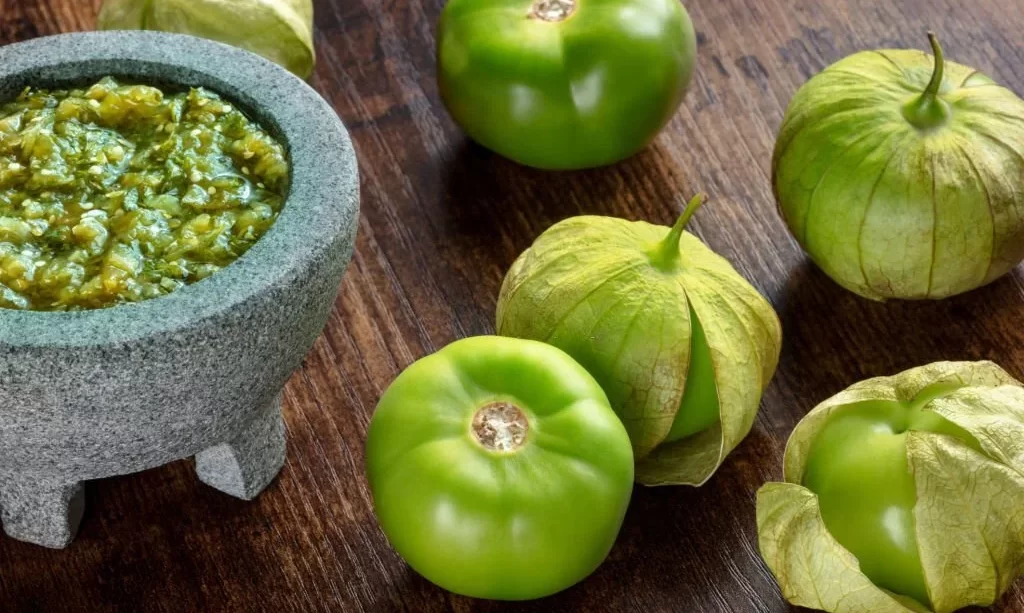In the vibrant world of culinary exploration, few ingredients can match the versatility and unique flavor of tomatillos. These small, green orbs, encased in delicate papery husks, have a tangy and slightly citrusy taste that adds a delightful twist to a wide range of dishes. Tomatillos are especially celebrated in Mexican and Latin American cuisines, where they play a starring role in classics like salsa verde. However, the bounty of tomatillos can sometimes lead to questions about how to preserve their freshness for future culinary adventures. In this guide, we’ll delve into the art of freezing tomatillos, a practical method that allows you to enjoy these culinary gems year-round.
- One pound of locally grown tomatillos
- Selection varies based on seasonal availability
- Perfect for salsa!
- Farm-fresh produce sourced from local farms and farmers markets.
- Eat healthy; support the local economy and environment.
Tomatillos – A Culinary Gem
Before we explore the world of freezing tomatillos, let’s take a moment to appreciate their significance in the culinary realm. Tomatillos, often referred to as “green tomatoes” or “Mexican husk tomatoes,” are not to be confused with traditional red tomatoes. They come in a variety of colors, including green, purple, and yellow, and are known for their tart and slightly acidic flavor. This distinctive taste, along with their vibrant color, makes them a prized ingredient in Mexican and Latin American dishes. One of their most famous roles is as the star of salsa verde, a zesty green sauce that accompanies tacos, enchiladas, and more. The culinary possibilities with tomatillos are endless, making them a true gem for home chefs and food enthusiasts alike.
Why Freeze Tomatillos?
While fresh tomatillos are a culinary delight, there are times when you may find yourself with an abundance of these flavorful gems. This surplus can occur during the harvest season or when you stumble upon a great deal at the market. Freezing tomatillos offers a practical solution to these situations and comes with several benefits:
- Reducing Food Waste: Freezing tomatillos allows you to extend their shelf life, preventing them from going to waste if you can’t use them all immediately.
- Year-Round Availability: By freezing tomatillos, you ensure a readily available supply for future recipes, regardless of the season. This means you can enjoy the flavors of summer even in the depths of winter.
- Preserving Freshness: When done correctly, freezing can help maintain the freshness, color, and flavor of tomatillos, allowing you to enjoy their vibrant taste in your dishes.
As we journey deeper into the process of freezing tomatillos, we’ll explore the steps involved in preserving their culinary magic. Whether you’re a seasoned chef or a home cook looking to make the most of your tomatillo harvest, freezing is a valuable skill that opens up a world of culinary possibilities.
Preparing Tomatillos for Freezing
Before you can freeze tomatillos successfully, proper preparation is essential. Here’s how to get your tomatillos ready for the freezer:
- Selecting Ripe Tomatillos: Start by choosing ripe tomatillos. They should be firm, free from blemishes, and have a vibrant green color. Avoid tomatillos that are overly soft or have moldy spots.
- Removing the Husks: Tomatillos come wrapped in papery husks, which should be removed before freezing. Gently peel away the husks and discard them. Rinse the tomatillos under cool running water to remove any residue.
- Inspecting for Quality: Take a moment to inspect each tomatillo. Look for any signs of spoilage or damage, and trim away any problematic areas. This step ensures that only the best tomatillos make their way into your freezer.
Blanching Tomatillos
Blanching is a crucial step in freezing tomatillos as it helps preserve their color, flavor, and texture. Here’s how to blanch tomatillos effectively:
- Boiling Water Bath: Bring a large pot of water to a rolling boil. It should be deep enough to fully submerge the tomatillos.
- Blanching Time: Gently lower the prepared tomatillos into the boiling water. Blanch them for approximately 1 to 2 minutes. This brief blanching period is sufficient to deactivate enzymes that can cause the tomatillos to deteriorate during freezing.
- Ice Water Bath: After blanching, immediately transfer the tomatillos to a bowl of ice water. This rapidly cools them and halts the cooking process.
- Draining and Drying: Once the tomatillos are thoroughly cooled, drain them and gently pat them dry with a clean kitchen towel or paper towels. This step removes excess moisture, which can lead to freezer burn.
Freezing Tomatillos
With blanching complete, it’s time to proceed with freezing the tomatillos. There are various methods you can use depending on your preferences:
- Whole Tomatillos: If you plan to use whole tomatillos in future recipes, you can freeze them individually on a baking sheet until firm, and then transfer them to airtight freezer bags. This prevents them from sticking together and allows you to take out just the number you need.
- Sliced or Pureed: Alternatively, you can slice the blanched tomatillos or puree them before freezing. Package them in airtight containers or freezer bags, leaving some space at the top to accommodate expansion.
- Labeling: Whichever method you choose, don’t forget to label your containers or bags with the date of freezing. This ensures you can keep track of their freshness.
By following these steps, you’ll have successfully prepared and blanched your tomatillos for freezing, preserving their quality and flavor for use in a wide range of culinary creations, from zesty salsas to hearty soups and stews.
Storing Frozen Tomatillos
Storing frozen tomatillos properly is crucial to maintain their quality over time. Here’s how to store them effectively:
- Airtight Containers or Freezer Bags: Ensure that your frozen tomatillos are stored in airtight containers or freezer bags. This prevents freezer burn and keeps unwanted odors from affecting the flavor.
- Labeling: Clearly label each container or bag with the date of freezing. This helps you keep track of their freshness and use them in a first-in, first-out fashion.
- Storage Duration: While frozen tomatillos can maintain their quality for several months to a year, it’s best to use them within the first 6-12 months for optimal taste and texture.
- Splatter-resistant microwaving with built-in vents under latches; resists stains and odors for long-lasting use
- Stacks perfectly to one another to save space and stay organized in the pantry or fridge
- International products have separate terms, are sold from abroad and may differ from local products, including fit, age ratings, and language of product, labeling or instructions
- Safe for the dishwasher, microwave and freezer
Using Frozen Tomatillos
The versatility of frozen tomatillos makes them a valuable addition to your culinary repertoire. Here are some creative ideas and recipes for using them:
- Salsa Verde: Thawed tomatillos are perfect for making vibrant and zesty salsa verde. Blend them with ingredients like cilantro, onions, and jalapeños for a flavorful condiment.
- Soups and Stews: Add frozen tomatillos directly to soups, stews, and chili for a burst of tangy goodness. They complement both vegetable and meat-based dishes.
- Sauces: Create delicious sauces for enchiladas, tacos, or grilled meats by blending thawed tomatillos with herbs and spices.
- Smoothies: For a unique twist, toss frozen tomatillos into your morning smoothie for a refreshing burst of tartness.
- Pasta Dishes: Thawed and pureed tomatillos can be used as a base for pasta sauces, adding a refreshing twist to your favorite pasta dishes.
Precautions and Considerations
While freezing tomatillos is a practical way to enjoy their flavors year-round, there are some considerations to keep in mind:
- Freezer Burn: To prevent freezer burn, ensure that your containers or bags are airtight and that you remove excess air before sealing.
- Quality Check: When using frozen tomatillos, give them a quick visual and sensory check. While they may change slightly in texture after thawing, they should retain their flavor and vibrant color.
- Thawing: When you’re ready to use frozen tomatillos, thaw them in the refrigerator for the best results. Avoid thawing them at room temperature, as this can lead to undesirable texture changes.
- Use Within a Reasonable Time: While frozen tomatillos can be stored for an extended period, it’s best to use them within the recommended storage duration for the freshest taste.
Conclusion: Enjoying Tomatillos Year-Round
Freezing tomatillos is not just a practical way to extend their shelf life; it’s a gateway to culinary creativity. With frozen tomatillos at your disposal, you can infuse your dishes with the unique tartness and zest that this beloved ingredient offers. Whether you’re crafting salsas, soups, or sauces, or experimenting with new recipes, the convenience of having tomatillos in your freezer means you can enjoy their flavors year-round.
So, the next time you stumble upon an abundance of fresh tomatillos or simply want to savor the essence of summer in the midst of winter, remember that freezing tomatillos is your ticket to enjoying their culinary magic whenever your taste buds desire. By following these steps and considerations, you’ll be well-equipped to embrace the world of frozen tomatillos and elevate your culinary adventures to new heights.





